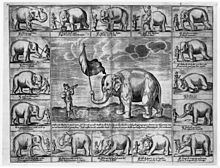 | ||
Hansken (1630 – Florence, 9 November 1655) was a female elephant that became famous in early 17th-century Europe. She toured many countries, demonstrating circus tricks, and was sketched by Rembrandt and Stefano della Bella.
Hansken was born in what was then Ceylon and was brought to Holland in 1637. Her name is a Dutch diminutive form of the Malayalam word aana, meaning "elephant". Rembrandt saw her in Amsterdam in 1637, and made four sketches of her in chalk.
Hansken toured fairs in the Netherlands and Germany. She appeared in Hamburg in 1638, in Bremen in 1640, in Rotterdam in 1641, in Frankfurt in 1646 and 1647, and in Lüneburg in 1650. She was probably in Leipzig in 1649 and 1651.
In the 17th century, it was believed that elephants had very advanced intellectual abilities. Following Pliny, it was thought that the elephant was the nearest to man in intelligence, and that elephants could understand speech, follow orders, and had a sense of religion and conscience. Pliny even reports that an elephant had learned to write words in the Greek alphabet. Hansken did not live up to these expectations, but she could wave a flag, fire a pistol, strike a drum, hold out her front feet, pinch money from pockets, put on a hat, carry a bucket of water, and pick up coins from the ground.
In July 1651, Hansken travelled to Zürich, Solothurn, Bregenz and St. Gallen, and on to Rome. She visited Florence, where she was drawn by artist Stefano della Bella. On the way back from Rome, the elephant died in Florence and Della Bella also drew her corpse after her death on 9 November 1655.
The skeleton of Hansken is still preserved in Florence, Museo della Specola, but the skin, mounted on a wooden support, is now lost.
